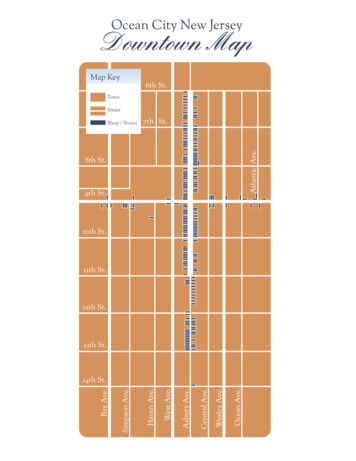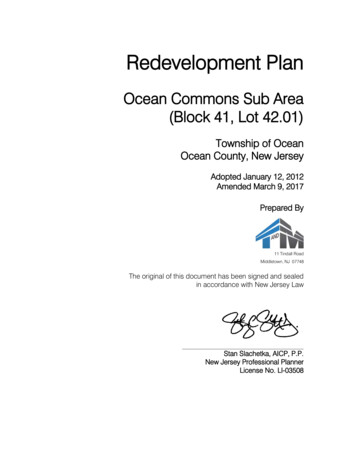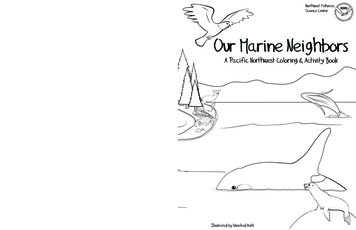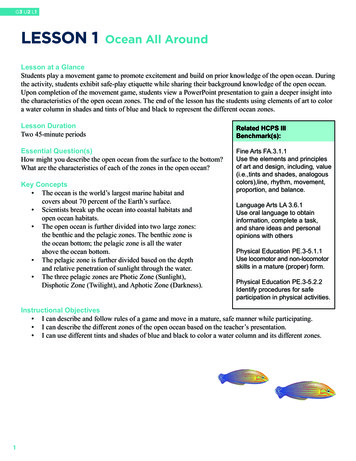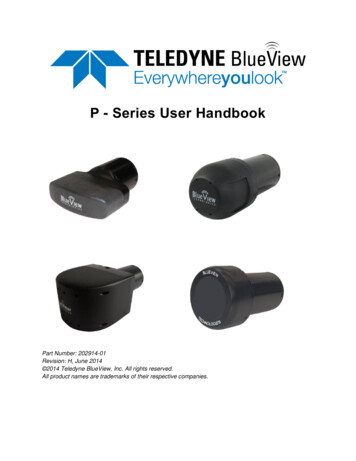
Transcription
P - Series User HandbookPart Number: 202914-01Revision: H, June 2014 2014 Teledyne BlueView, Inc. All rights reserved.All product names are trademarks of their respective companies.
Table of ContentsChapter 1: Welcome . 5About the Teledyne BlueView, Inc. Sonar . 5Chapter 2: System Contents . 5Chapter 3: Understanding Imaging Sonar . 6What is Imaging Sonar? . 6How do I interpret the Sonar Images?. 6Chapter 4: Sonar System Installation . 7Install Software on your PC . 7Set your PC's network card IP address . 8Assemble the System . 9Required Cables . 9Installation Procedure . 10Firewall Configuration . 10Chapter 5: Sonar Installation . 11Mount the Sonar . 11Mounting Method . 11Mounting Location . 11Sonar Up-Down Orientation . 11Sonar Angle . 12Wiring the Cable Whip . 13Test the System . 13Precautions . 13Chapter 6: Sonar Operation . 13Connect to the Sonar . 13Dual Frequency Sonars . 14Video Synchronization . 14Geo Location (Georeferencing) . 15Record/Play Back Video . 15Image Calibration . 15Shutdown . 16Maintenance . 16 Teledyne BlueView Inc.Page 2
Chapter 7: Troubleshooting . 17If the ProViewer Software cannot see the sonar head: . 17If the image updates seem slow . 19Still not working? . 19Appendix A: Technical Specifications . 20Appendix B: Mechanical Drawings . 22P450-45 Outline Drawing: . 22P450-90/130 . 23P900/2250-45 Outline Drawing . 24P900-45, P900-90, and P900-130 Outline . 25Appendix C: Cable Diagrams . 26 Teledyne BlueView Inc.Page 3
Teledyne BlueView, Inc. has made every effort to ensure the accuracy andcompleteness of this document; however, because ongoing development efforts aremade to continually improve the capabilities of our products, we cannot guarantee theaccuracy of the contents of this document. We disclaim liability for errors, omissions, orfuture changes herein.Copyright 2014 Teledyne BlueView, Inc. Corp. All rights reserved. No part of thispublication may be copied, reproduced, or translated, without the prior written consentof Teledyne BlueView, Inc. No part of this publication may be stored or transmitted inany electronic form without the prior consent of Teledyne BlueView, Inc. Anyunauthorized use is a violation of copyright laws.Warning! This device should not be used as a navigational aid to prevent collision,grounding, boat damage, or personal injury.Warning! This product contains lead, a chemical known to the state of California tocause cancer, birth defects and other reproductive harm. Handling and/or opening thisunit may result in exposure to lead, in the form of solder.Warning! Disassembly and repair of this electronic unit should only be performed byauthorized service personnel. Any modification of the serial number or attempt to repairor disassemble the original equipment or accessories by unauthorized individuals willvoid the warranty.Warning! Changes or modifications to this unit not expressly approved by the partyresponsible for compliance may void the user’s authority to operate this equipment.Warning! This equipment contains High Voltage electronics. Tampering with or usingdamaged equipment could lead to serious injury.Warranty Information:The sonar is backed by a standard 12-month parts and labor warranty policy. Seller’sTerms and Conditions of Sale can be found at www.blueview.com.For more information on safety and/or maintenance issues please call TeledyneBlueView, Inc. at 425.492.7376. Teledyne BlueView Inc.Page 4
Chapter 1: WelcomeCongratulations on your purchase of a Teledyne BlueView, Inc. 2D Miniature Multibeam Imaging Sonarsystem. This manual covers operations of the P-Series sonar systems.Teledyne BlueView, Inc. 2D imaging sonar provides streaming sonar imagery, making it easy to searchand navigate in low and zero visibility water. Teledyne BlueView, Inc. has coupled high-performanceimaging capability with a powerful software package creating one of the world’s most versatile underwaterimaging systems available today.Advanced sonar technology, rugged design, and powerful software are just a few highlights of your sonarsystem. This manual explains imaging sonar interpretation and provides instructions on the installationand operation of your sonar system. For detailed information on using the sonar imaging software, pleasesee the ProViewer Software Handbook found both on the software CD as well as under the software’shelp menu.About the Teledyne BlueView, Inc. SonarYour sonar is a general-purpose underwater imaging sonar designed for ROV, AUV, vessel mounted, andstationary tripod integration. With its Ethernet interface and user-friendly software, the sonar system isdesigned to be just as easy-to-use as it is functional.Chapter 2: System ContentsAll Teledyne BlueView, Inc. P-Series sonar systems come with the sonar head and an accessory kit. Theaccessory kit contains the following:DescriptionPower-Over-Ethernet (POE) BoxSonar to Surface Cable (25 ft.)Cable Whip (4 ft.)Ethernet Cable (7 ft.)ProViewer CDQuickstart GuideUser HandbookRugged Carry Case Teledyne BlueView Inc.Page 5
Chapter 3: Understanding Imaging SonarWhat is Imaging Sonar?Many people are familiar with scanning type sonar, which employ mechanical rotation of a single acousticbeam over an imaging area. This works well when used on stationary platforms and/or when imagingstatic targets. They become much less useful when working from a moving platform and/or trying toimage moving targets since any motion can cause errors in the final image. By comparison, TeledyneBlueView, Inc. imaging sonar are multi-beam sensors, which form many small acoustic beams at once.This allows them to work well from stationary and moving platforms. An imaging sonar can produceseveral high-quality images per second, making it possible to get movie-like imagery from the sonar.How do I interpret the Sonar Images?Imagine a flashlight lying on a table and an object such as a coffee cup located in front of the flashlight. Ifyou look down on this scene, you will see a bright area where light is reflecting off the face of the coffeecup. You will also see a dark shadow behind the coffee cup where light is unable to reach. The same ideacan be applied to a Teledyne BlueView, Inc. imaging sonar by replacing the light source with a soundsource. Bright areas on the sonar image are the result of objects reflecting sound, while dark areas areacoustic shadows resulting from an object blocking the sound. The two figures below provide an exampleof how a given scene would appear when viewed visually and with high-definition imaging sonar: Teledyne BlueView Inc.Page 6
Chapter 4: Sonar System InstallationThe following chapter contains step by step instructions for setting up your Teledyne BlueView, Inc.sonar. For more information on the specifics of operating the sonar, see the ProViewer SoftwareHandbook found both on the software CD as well as under the software’s help menu for more informationabout your ProViewer Software.Install Software on your PCTo install ProViewer, just insert the ProViewer CD into your computer’s CD-ROM drive. You may alsolaunch the installation by double clicking on setup.exe in the CD’s root directory. Follow the instructions tocomplete the installation.If you have a personal firewall enabled you may receive a warning message saying that ProViewer isattempting to send information to the Internet. These messages are caused by ProViewer looking forTeledyne BlueView, Inc. sonar on your network. Teledyne BlueView, Inc. recommends that you select theoption that will always allow ProViewer to access the network. For example, in the image below, clickUnblock. Teledyne BlueView Inc.Page 7
Set your PC's network card IP addressIn Windows, open the ‘Control Panel’. In the control panel, open the ‘Network connections’ folder. In‘Network connections’ folder, select the interface you’ll be attaching the sonar to. This interface iscommonly called ‘Local Area Connection’, but might have another name in your particular application. Inthe ‘Local Area Connection’ window, select ‘Properties’ In the ‘Properties’ window, select ‘InternetProtocol’ and click on the ‘Properties’ button. In the resultant ‘Internet Protocol (TCP/IP) Properties’window, configure it as shown below:After you’ve set the IP address and Subnet mask as shown, close all the windows you just opened. Teledyne BlueView Inc.Page 8
Assemble the SystemAfter installing the PC software found on the included CD, the sonar system can be connected for abench-top test. The standard sonar package comes with everything needed to get up and running quickly.The only additional item required is an AC power source (your typical wall plug). The figure below depictshow the components are interconnected. Your sonar may look different than the one depicted below.Required CablesAC Power Cable Teledyne BlueView Inc.25 ft Sonar to Surface CableStandard Ethernet CablePage 9
Installation Procedure1. Inspect all cable connector contacts for lack of moisture, corrosion, or damage before assembling thesystem.2. Connect the 10 pin underwater connector on the “25ft Sonar to Surface Test Cable” to the matingbulkhead connector on the rear of the sonar head. Make sure that all o-rings are present and in goodshape before making the connection. Once connected, ensure that the connector is fully engaged andtightened.3. Connect the RJ45 connector on the Sonar to Surface Test Cable to the “SONAR J1” port on the POEBox.4. Connect one end of the Standard Ethernet Cable to the “PC J2” port on the POE Box.5. Connect the other end of the Standard Ethernet Cable to the Ethernet port on the User computer.6. Plug the POE box power cable into a standard 120 VAC wall outlet. The sonar head will power up andinitialize itself in approximately 40 seconds.Note: When power cycling, correct operation requires that power be cycled from the AC side of the POEbox. If you cycle the power off briefly, make sure you leave the power unplugged for at least 10 seconds.7. Turn on your computer.8. Start ProViewer, and click the “Connect” button.If ProViewer is able to connect to the sonar, the bench top test is successful. If not, refer to Chapter 7,“Troubleshooting.”Firewall ConfigurationProViewer Software communicates with the sonar head using standard networking protocols. If your PChas firewall software, you may see a warning ‘popup’ that asks permission to allow the ProViewerSoftware to connect to the sonar. In that case, you may need to configure your PC’s firewall to allowcommunications between your sonar and your PC using TCP and UDP on port 1149. Refer to your antivirus/firewall software vendor or your computer tech support resources for assistance with your antivirus/firewall software. Teledyne BlueView Inc.Page 10
Chapter 5: Sonar InstallationMount the SonarAfter installing your software and running your sonar for the first time, you’re ready to put the sonar intothe water.Mounting MethodIn order to do this, the sonar needs a mounting structure to hold it securely in its underwater environment.This mount can either be one purchased from Teledyne BlueView, Inc., or a customer supplied mount.The preferred mounting method is a clamp type fixture around the cylindrical portion of the unit. Forcustom mounts, refer to the technical drawings provided in the appendix of this manual for sonardimensions.Mounting LocationThe sonar images like a camera out of the front of the nose cone. It should be mounted looking forward,preferably on the same pan-and-tilt as the ROV’s main camera.Sonar Up-Down OrientationUse the stickers and connector placement on the rear end cap, or the BlueView Logo on the front of thesonar to determine the up-down orientation of the sonar.TopTopBottomBottom Teledyne BlueView Inc.Page 11
Sonar AngleTo achieve optimal performance while imaging targets and/or the bottom at a given depth, the angle thatthe sonar is tilted down from the surface is important. This issue is demonstrated in the figures below. Onthe left, the sonar is tilted down at a steep angle that provides only a narrow field of view of the bottom.The sonar on the right-hand figure is set at a much shallower angle that provides both a betterperspective on targets and a larger field-of-view of the bottom.The sonar’s steep tilt-angle in this figure producesimagery of a narrow strip of the bottom.The sonar’s shallow tilt-angle in this figureproduces an image of the bottom over a broadarea. In general, shallower tilt-angles, which givelarger areas of bottom imaging, are preferred.Recommended tilt angles.TargetDepth (ft)0102030406080Approx.03810101520TiltAngle(Deg) Teledyne BlueView Inc.Page 12
Wiring the Cable WhipLocate the cable wiring diagram in appendix C of this manual for the correct type of connector on yoursonar.Test the System Apply power to the systemStart ProViewer softwareOnce the sonar is fully powered up (approximately 45 seconds) click the connect buttonPrecautions When power cycling the sonar, be sure to allow at least 10 seconds of "off time" before turningthe sonar back on.If your network configuration requires a different sonar IP address than the factory default, youcan change it within the ProViewer application. If you decide to do that, you must change yourPC’s IP address and net mask to compatible settings. Refer to the ProViewer softwaremanual included in your ProViewer CD for more information about sonar IP addressing.Chapter 6: Sonar OperationConnect to the SonarOnce you’ve verified your computer is correctly configured and your hardware components areconnected, start the ProViewer software and click the ‘connect’ icon.ConnectThe ProViewer software should connect to the sonar head. If ProViewer can not connect to the sonar,see the trouble shooting section of this handbook. Teledyne BlueView Inc.Page 13
Dual Frequency SonarsSome BlueView products operate at more than one center frequency. Those sonars are called ‘multihead’ sonars. When connecting to a multi-head sonar, the ‘Sonar Devices’ window will show you all thesonar heads available to connect to:Simply double-click the head you want to use, or select the head and click the ‘connect’ button.If already connected to a sonar head, you can switch which head you are using with the ‘Head’ dropdown menu:Video SynchronizationUsing your P Series sonar you can easily connect the ROV's (Remote Operated Vehicle) onboard videocamera feed to simultaneously record time-synchronized sonar and video imagery to enhance navigation.For details on how to connect the video camera feed and synchronize it with your BlueView P Seriessonar please refer to page 31 in the ProViewer Software Handbook. The ProViewer handbook isavailable on the CD that ships with the P Series sonar, or available on the BlueView website at:http://www.blueview.com/proviewer-software.html Teledyne BlueView Inc.Page 14
Geo Location (Georeferencing)BlueView P Series sonar accepts industry standard NEMA input for GPS position, heading, and depthfrom common GPS devices, compasses, and depth sensors. BlueView's ProViewer software displays theinformation on screen and saves to file with sonar data for post mission analysis. For details please referto page 29 in the ProViewer Software Handbook. The ProViewer handbook is available on the CD thatships with the P Series sonar, or available on the BlueView website Record/Play Back VideoBlueView P Series sonar and ProViewer software enable you to record and play back video captured bythe ROV's (Remotely Operated Vehicle) onboard video camera feed and places it into an .avi file for postmission analysis. For details please refer to page 31 in the ProViewer software handbook. The ProViewerhandbook is available on the CD that ships with the P Series sonar, or available on the BlueView re.htmlImage CalibrationIf an image looks broken or misaligned, CTRL-J will bring up the Image Calibration dialog. Teledyne BlueView Inc.Page 15
ShutdownTo shutdown the sonar, close the “Sonar Window” by clicking on the “X” icon in the top right-hand cornerof the window, or select Exit from the File menu to close the entire program. It is now safe to powerdown the sonar or disconnect the Ethernet cable from the computer.MaintenanceTo ensure continued good operation of your sonar system, follow these practices:1. After use in salt water, rinse the sonar head and connectors off with fresh water, blow connectorcontacts clean and coat lightly with dielectric grease.2. Before use, ensure connector contacts are clear of dirt and corrosion and protected with dielectricgrease. Teledyne BlueView Inc.Page 16
Chapter 7: TroubleshootingIf the ProViewer Software cannot see the sonar head:Possible CausePossible SolutionNo PowerConfirm that the ProViewer Junction (POE) Box is plugged into astandard 120VAC outlet and that the small green LED on the POE Boxis glowing. Also check that the Sonar-to-Surface cable is plugged intothe “SONAR J1” port on the POE Box.Improperly connectedIn addition to the connections described above, verify that you have agood cable between the computer Ethernet port and the “PC J2” port onthe POE Box.Bad StateReset the sonar by removing the POE box AC power cord for 10seconds. The sonar head takes 40 seconds to reboot after power is reapplied.Dirty ConnectorsMake sure that all connector pins are clean and corrosion free.The sonar head cabling is conveniently designed so that you canconnect your POE Box to a PC with a standard Ethernet cable.Improper Ethernet CableThe price for this convenience is paid when connecting your POE Boxto a network hub. In this case, you will need to use a ‘crossover’Ethernet cable unless your network hardware is capable automaticallyhandling ‘crossed’ Ethernet cables.Sometimes the PC ‘arp’ table is corrupted and requires repair. Thereare several ways to do this, depending on your particular OS. OnWindows you can: repair the arp table via the desktop notification areaicon:PC Networking Software isConfusedYou can also simply restart the computer. Depending on your particularsituation, it may also be helpful to cycle the power on the sonar. In thiscase, be sure to leave the sonar power disconnected for a full 10seconds before restoring power.IP Subnet Masks don't match Teledyne BlueView Inc.Make sure the subnet mask is the same on both PC and sonar. Forthe factory default ‘Class C network’ configuration, the subnet mask is255.255.255.0. The ‘255’ part of the mask defines the ‘network’ part ofthe IP address. The ‘0’ part of the mask defines the ‘device’ part of theIP address.Page 17
IP Network Addresses don'tmatchMake sure the IP *network* part of the IP address is the same on boththe sonar and the computer. In the factory default case, this is the first 3numbers in the IP address: 192.168.1.IP Network DeviceAddresses are the sameThe device part of the IP address must be *different* for every deviceon the network. In the factory default case, the sonar is set to 45 andthe PC is set to 3. Don’t use 255, it’s reserved for ‘broadcast’ use.Poor Connection QualityUse an ohm meter to verify Tx and Rx line connectivity between theEthernet connector that plugs into the PC and the 10 pin connector thatplugs into the sonar head. Refer to “ProViewer Sonar to Surface CableDrawing” in the Appendix for pin to pin connection information.To connect with the sonar, its IP address must be compatible with thenetwork or computer to which it is attached. If you mis-configure thesonar’s network settings and are unable to connect to it, follow thisprocedure to reestablish communications with the sonar:1. Connect the sonar communication cable directly to a Windows XPcomputer's network interface card.2. As described below in the "running the sonar on a network" section,open the "Internet Protocol" (TCP/IP) properties window for the networkinterface card you plugged the sonar into.You suspect you've misconfigured the sonar IPaddress3. Under the "General" tab, select "Obtain an IP address automatically."4. Under the "Alternate Configuration" tab, select "Automatic Private IPAddress" and click OK.5. Close the rest of the Windows folders you opened.6. Cycle the sonar power off (for at least 10 seconds), then turn thesonar back on.7. After about 100 seconds, the Windows PC and the sonar shouldhave negotiated "link local" IP address (in the range of 169.254/16).Using the ProViewer software, ‘connect’ normally and reconfigure thesonar’s network settings to be compatible with its intended network. Teledyne BlueView Inc.Page 18
If the image updates seem slowPossible CausePossible SolutionEthernet CongestionShut down other computers or services that are consuming the Ethernetnetwork bandwidth. The sonar requires about 10MBps of networkbandwidth to operate.Range SettingsWhen your sonar ‘pings’, it has to wait for the echo to return from adistant object; long ‘range’ settings directly cause slow updates. Reducethe ‘Range Stop’ distance to increase the update rate.GUI Window SizeThe larger the displayed sonar image is, the longer it takes for theProViewer software to construct the image. To increase the imagedisplay update rate, decrease the size of the sonar image displaywindow by grabbing one of sides or corner of the GUI and dragging ittowards the center of the GUI window.Still not working?Please contact us:Teledyne BlueView, Inc. Customer Supportwww.blueview.com425.492.7376 (011 for international calls)8am – 5pm PST Mon through Fri Teledyne BlueView Inc.Page 19
Appendix A: Technical 30P900/2250-4545º90º130º45º55m100m100m55m(180 ft.)(328 ft.)(328 ft.)(180 0 ft.)45º45º137m (450 137m (450ft.)ft.)1º x 15º1º x 15º1º x 15º1º x 20º1º x 20º1º x 20º1º x 20ºNumber of .18º0.18º0.18º0.18º0.18ºRangeResolution2 in.2 in.2 in.1 in.1 in.1 in.1 in.&0.4 in.UpdateRateUp To10 HzUp To10 HzUp To10 HzUp ToUp ToUp ToUp to15 Hz15 Hz15 Hz15 HzFrequency450kHz450kHz450kHz900kHz900kHz900kHz Teledyne BlueView Inc.900kHz &2.25 MHzPage 20
8.6 lb5.0 lb5.5 lb5.5 lb6.0 lbSonarWeightin Air5.7 lbWeightin Water1.4 lb2.9 lb2.9 lb1.1 lb1.4 lb1.4 lb1.5 00mSize*8.9 in. x7.0 in.8.9 in. x7.0 in.8.9 in. x7.0 in.11.3 in.x 5 in.O.D.11.3 in.x 5 in.O.D.11.3 in.x 5 in.8.3 in. x5.0 in.8.6 lb*See Outline Drawings for Exact Dimensions. Teledyne BlueView Inc.Page 21
Appendix B: Mechanical DrawingsP450-45 Outline Drawing: Teledyne BlueView Inc.Page 22
P450-90/130Units Inches Teledyne BlueView Inc.Page 23
P900/2250-45 Outline DrawingUnits Inches Teledyne BlueView Inc.Page 24
P900-45, P900-90, and P900-130 OutlineUnits Inches Teledyne BlueView Inc.Page 25
Appendix C: Cable DiagramsImpulse MKS ConnectorCable and Whip Pin Out DiagramRJ45 ConnectorImpulse Connector Part #BlueView #Mfr #200015-01MKS-310-CPP-RAINTERCONNECTION TABLEPROVIEWER-ERJ45CONDUCTOR COLORIMPULSEFUNCTION1ORANGE/WHITERx 12ORANGERx-23GREEN/WHITETx ITEDC Return78BROWNDC Return8The Tx/Rx lines are placed to be directly connected to a PC without a‘crossover’ cable. Supply power to pins 4,5 and 7,8 as shown above. Teledyne BlueView Inc.Page 26
Burton ConnectorCable and Whip Pin Out DiagramRJ45 ConnectorBURTON Connector Part # 5501-1508INTERCONNECTION OR COLOR1CAT5 ORANGE/WHITERx 12CAT5 ORANGERx-23CAT5 GREEN/WHITETx 312-48V44&5CAT5 BLUE, BLUE/WHITE*N/CCAT5 YELLOWN/A56CAT5 GREENTx-6DC Return7N/A87&8CAT5 BROWN,BROWN/WHITE*N/CCAT5 YELLOW/WHITE*These conductors are only on the whip and are not connected Teledyne BlueView Inc.Page 27
Teledyne BlueView, Inc. 2D imaging sonar provides streaming sonar imagery, making it easy to search and navigate in low and zero visibility water. Teledyne BlueView, Inc. has coupled high-performance imaging capability with a powerful software package creating one of the world's most versatile underwater imaging systems available today.

